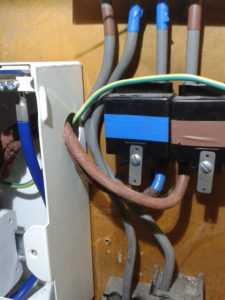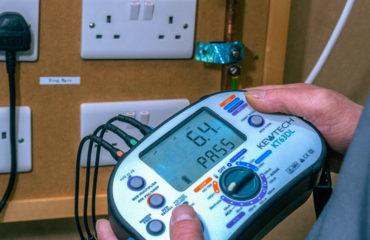Guidance on Omission of RCD Protection for Sockets- 18th edition
Do all sockets need to be RCD protected is one of the most popular questions we get asked within our centres.
1. The Wiring Regulations.
Electrical Installations are required to comply with British Standard 7671 The Requirements for Electrical Installations known as the Wiring Regulations 18th Edition.
A new edition of the Wiring Regulations (18th Edition) was published on the 2nd July 2018. Installations designed after the 31st December 2018 must comply with the new edition and designers may use the new edition for design purposes before that date.
This new edition has made changes to the requirements for the protection of socket outlets by the use of 30mA (30 milli-amps) Residual Current Devices (RCDs).

2. RCD Protection
RCD protection provides Additional Protection against electric shock to users of the electrical installation who may accidentally come in to contact with live parts. This could happen if the casing of an appliance was broken, the supply flex to an appliance was cut or damaged, water or another liquid penetrated the appliance casing, the appliance was dropped in to water, a user pulled out a plug with wet hands or an appliance became defective etc.
To provide this Additional Protection against electric shock the RCD has to be rated at 30mA or less, a higher rated RCD will not provide Additional Protection.
RCD protection can be fitted at the distribution (fuse) board to provide protection for one or more sockets on a circuit. Alternatively, individual sockets can be fitted with integral RCD protection.
3. What sockets require 30mA RCD Protection?
The following sockets are required to have 30mA RCD protection to comply with the latest edition of BS7671.
1. Sockets with a rated current not exceeding 32A (Amps). That is sockets rated at 2A, 5A, 13A, 15A, 16A and 32A (both single and 3 phase). There are special exceptions to this, see below in Paragraph 4.
2. Sockets rated up to 32A (both single and 3 phase) that could be used to supply mobile equipment outdoors. Those are sockets near outside doors or are fitted outside a building. There are no exceptions to this.
3. Sockets in bathrooms or other rooms containing a bath or shower; however the socket must be at least 3metres from the bath or shower. No exceptions.
4. Special sockets near swimming pools. Your electrical contractor will be able to advise you on the special requirements.
5. Sockets in Agricultural and Horticultural Premises such as farms and garden centres. Your electrical contractor will be able to advise you on the other special requirements.

6. Sockets on caravan and camping sites.
7. Sockets in caravans.
8. Sockets in Marinas and similar locations.
9. Medical locations. Your electrical contractor will be able to advise you on the other special requirements for this location.
10. Sockets for use in exhibitions, shows and stands.
11. Sockets for use in temporary installations, amusement devices, booths, fairgrounds, amusement parks and circuses.
12. Sockets for electric vehicle charging points.
4. Exceptions
1. There are no exceptions for dwellings.
2. For sockets not in 2-12 above and, not in a dwelling, RCD protection may be omitted if there is a documented formal Risk Assessment that determines RCD protection is not necessary.
5. Omission of RCD protection with formal written Risk Assessment.
The designer of a new electrical installation is required to obtain from the client a formal written risk assessment if RCD protection is to be omitted from any socket up to 32A rated. On completion of the electrical installation the Regulations require the new work to be inspected and tested by a person known as an Inspector. This Inspector should inspect and test the new installation, during construction and on completion before the installation is put into service. The Inspector will verify that the new installation complies with the Wiring Regulations and will issue either an Electrical Installation Certificate or, for an addition or alteration that does not involve the provision of a new circuit a Minor Electrical Installation Works Certificate, to certify that the installation complies with the Wiring Regulations and is safe to use. If RCD protection is omitted for one or more sockets the Inspector will need to attach the formal Risk Assessment to the certificate and verify this has been done on the certificate.
6. How an RCD provides additional shock protection.
An RCD continually monitors the flow of current in and out of a circuit. The current flow into a circuit needs to be the same as the current flow out of the circuit. If the current flow in is different to the current flow out it means that some current is flowing to earth this is known as earth leakage. An electric shock is the flow of current through the body, the magnitude and the duration of that current flow will determine if any injury is caused or if the shock could be fatal. An RCD does not limit current flow or voltage it protects by limiting the time that any earth leakage current of a certain magnitude can flow. For shock protection the RCD is required to limit that time to 40ms (40 milli-seconds) or less. A typical 30 mA RCD will trip if it detects an earth leakage current flow of around 18-22 mA causing the RCD to operate and cut of the electrical supply to prevent a fatal shock.
7. Nuisance tripping.
It is very rare for an RCD to become faulty so that it trips for no reason or at a current less than the typical tripping current for the device. RCDs get a bad press for doing what they are designed to do and that is to trip if they see an unacceptable flow of earth leakage due to a dangerous condition.
RCDs may trip for unexpected reasons under non-fault conditions and these are known as nuisance tripping. Nuisance tripping can be caused for the following reasons.
1. Electronic equipment have special devices fitted inside them known as noise filters. These filters operate by leaking some current under normal conditions to earth. This current could be up to 3mA per item of electronic equipment. One piece of equipment on a 30mA circuit will not trip an RCD. However, if a number of electronic appliances are connected to a single RCD the total earth leakage of all the appliances added together may exceed the typical tripping current. If the leakage is not enough to trip the RCD instantaneously it may make it prone to tripping through disturbances on the supply. See below.
2. The supply coming into a building may not be a “clean” supply. It may have irregularities in voltage and current waveforms know as voltage disturbances or transients. These are caused by the supply company switching their network equipment to maintain the supply voltage, faults on the supply network, switching of large loads in other consumers premises and lightning strikes on the supply cables for example. In addition, the switching of large loads in the consumers premises such as large motors and voltage disturbances through connected equipment such as welding plant. These transients may cause nuisance tripping of RCDs under no fault conditions. Loose and poor terminations of supply and installation cables and conductor terminations may also cause nuisance tripping.
3. Nuisance tripping may be caused by nearby radio transmitters. Operation of hand held 2 way radios close to distribution boards may cause nuisance tripping. This is not usual but may happen if the radio aerial is close to the equipment.
8. Reducing the risk of Nuisance Tripping.
The probability of nuisance tripping may be reduced by adopting one or more of the measures set out below.
1. Instead of a single RCD protecting a number of circuits install more RCDs protecting fewer circuits.
2. Instead of an RCD protecting a number of circuits protect individual circuits with and RCBO. An RCBO is a replacement for the ordinary circuit breaker that performs the function of a circuit breaker but in addition has an RCD function.
3. Where a circuit supplies a number of sockets that are used to supply electronic equipment, limit the number of sockets on the circuit and have more circuits to say limit the number of electronic devices to 5 or 6.
4. Instead of protecting a circuit with an RCD or RCBO replace the ordinary sockets with sockets with an integral RCD.
5. Connect critical pieces of equipment directly to a switch fused connection unit or isolator to eliminate the plug and socket.
6. To reduce the risk from transients on the supply fit surge protection devices at the origin of the supply and at distribution boards.
7. To ensure that there is no degradation of the continuity of the terminations of the tightness of all terminations.
9. Producing the Risk Assessment Document
The Risk Assessment will need to be carried out in accordance with The Management of Health and Safety at Work Regulations 1999 (SI 199 No. 3242) (MHSW) as amended. The MSHW requires the Risk Assessment to be carried out by a person competent to perform the task. The person carrying out the Risk Assessment must be prepared to justify his/her considerations and conclusion. The decision to omit RCD protection, for say a socket that supplies a critical piece of equipment, is a very serious step to take and if a person were to be injured or killed due to the omission of this shock protection the person carrying out the risk assessment may be personally liable and subject to prosecution if the risk assessment process was found to be defective. It is not acceptable to omit RCD protection purely for financial reasons.
The Risk Assessment is subject to continuous review in the same way as other risk assessments. If there were to be a material change to the premises, the premises use, the premises ownership, work practices or users of the installation the Risk Assessment would need an immediate review. It is not appropriate for the designer or electrical contractor to carry out the Risk Assessment as he/she will not be in possession of all the details of the client’s work processes or procedures to satisfy the requirements of the MSHW. In addition, the designer or electrical contractor would not be able to carry out the ongoing review of the Risk Assessment. If the client is not able to carry out the Risk assessment they should engage the services of a competent Health and Safety professional who is competent to carry out this to of risk assessment and who is registered with the Institution of Health and Safety (IOSH). If the outcome of the Risk Assessment is to omit RCD protection from one or more sockets the written document must be passed to the Designer of the Installation. The Risk assessment is to be appended to the Electrical Installation Certificate or the Minor Works Electrical Installation Certificate.
10. Considerations for the Risk assessment.
You may wish to consider one or more of the following provisions.
1. Could a special socket be used to prevent ordinary 13A plugs from being inserted?
2. Could an interlocked socket be used where the socket cannot be energised without the plug having been inserted and the plug cannot be withdrawn without the socket being isolated by an integral switch?
3. Could the socket be restricted to the use of Class 2 appliances and the user inspects the flex to the appliance each time before use. Is there a very low risk from the flex being damaged?
4. Can you restrict access to the socket to prevent misuse?
5. Can you label the socket for use for a particular piece of equipment?
6. Who is going to use the socket? Can you restrict use to electrically skilled persons?
7. Could special instructions be displayed near the socket?
8. Is management supervision in place to ensure safe use of the socket?
9. Is there a system of inspection and testing in place to ensure the equipment to be plugged in to the socket safe to use?
10. If the socket is used to supply, say an IT rack, is there a separate, permanently connected, earth connection in place to the equipment?
11. Is a separate means of isolation available to disconnect the supply to the socket before the plug inserted or withdrawn? A circuit breaker could be used for this purpose if a skilled or instructed person was to perform this task.
Hopefully this will give you some help when asking yourself, do all sockets need to be RCD protected?




